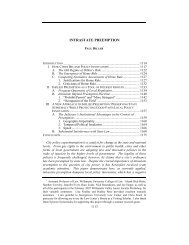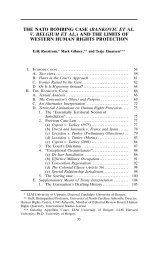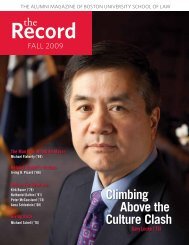the nature of representation: the cherokee right ... - Boston University
the nature of representation: the cherokee right ... - Boston University
the nature of representation: the cherokee right ... - Boston University
You also want an ePaper? Increase the reach of your titles
YUMPU automatically turns print PDFs into web optimized ePapers that Google loves.
2005] THE NATURE OF REPRESENTATION 131<br />
As this chart shows, <strong>the</strong> Cherokee delegate would represent a population in line<br />
with that <strong>of</strong> <strong>the</strong> o<strong>the</strong>r non-voting delegates.<br />
IV. CHALLENGES TO THE DELEGATE RIGHT<br />
This Section examines <strong>the</strong> three principal arguments against Cherokee exercise <strong>of</strong><br />
<strong>the</strong>ir treaty-based <strong>right</strong> to a Congressional Delegate. First, that <strong>the</strong> <strong>right</strong> has been<br />
lost; second, that <strong>the</strong>re is a definitional problem regarding whom <strong>the</strong> delegate<br />
represents; and finally, that exercising <strong>the</strong> delegate <strong>right</strong> would infringe on <strong>the</strong><br />
constitutional <strong>right</strong>s <strong>of</strong> non-Cherokees. 207<br />
The purpose <strong>of</strong> examining <strong>the</strong>se<br />
criticisms is both practical—to present <strong>the</strong> challenges facing <strong>the</strong> Cherokee Nation<br />
should it pursue its treaty <strong>right</strong>—and intellectual—to use <strong>the</strong> possibility <strong>of</strong> <strong>the</strong><br />
Cherokee delegate as a vehicle for exploring <strong>the</strong> <strong>nature</strong> <strong>of</strong> American democratic<br />
<strong>representation</strong>. While <strong>the</strong> history <strong>of</strong> removal and <strong>of</strong> <strong>the</strong> Treaty <strong>of</strong> New Echota<br />
negotiations are important for understanding <strong>the</strong> basis for <strong>the</strong> Cherokee delegate<br />
INDIANS, 24th Cong., 1st Sess., 54-61.<br />
2) “The number <strong>of</strong> <strong>the</strong> Cherokee tribe <strong>of</strong> Indians yet remaining east <strong>of</strong> <strong>the</strong> Mississippi<br />
river is supposed to be fourteen thousand, and <strong>the</strong> number <strong>of</strong> those who have emigrated<br />
west <strong>of</strong> that river, in conformity with <strong>the</strong> late treaty between that tribe and <strong>the</strong> United<br />
States, is two thousand one hundred and three.” Letter from Joel R. Poinsett, Sec. <strong>of</strong> War,<br />
to James K. Polk, Speaker <strong>of</strong> <strong>the</strong> House (Jan. 8, 1838), micr<strong>of</strong>ormed on CIS House 325<br />
H.doc. 82, 1 (Cong. Info. Serv.).<br />
3) Schermerhorn also had a higher estimate in a chart with 16,542 total Cherokees in<br />
North Carolina, Tennessee, Alabama, and Georgia; and 201 Whites connected by<br />
marriage. Letter from John F. Schermerhorn to Lewis Cass (Mar. 3, 1836), in TREATY WITH<br />
THE CHEROKEE INDIANS, 24th Cong., 1st Sess., 54-61.<br />
4) According to a Cherokee population historian in 1835 <strong>the</strong>re were 21,542<br />
including 5,000 already emigrated West. RUSSELL THORNTON, THE CHEROKEES: A<br />
POPULATION HISTORY 51 (1990).<br />
5) John Ross, arguably <strong>the</strong> person with <strong>the</strong> best sense at <strong>the</strong> time, wrote, “The<br />
population <strong>of</strong> <strong>the</strong> Cherokee Nation East <strong>of</strong> <strong>the</strong> Mississippi is between 16 & 17,000 . ..<br />
[and with <strong>the</strong> Western Cherokees] <strong>the</strong> whole population would <strong>the</strong>n be about 20000<br />
souls.” Letter from John Ross to Joaquin Maria del Castillo y Lanzas (Mar. 22, 1835), in<br />
1THE PAPERS OF CHIEF JOHN ROSS, supra note 14, at 335.<br />
206 This is <strong>the</strong> population <strong>of</strong> <strong>the</strong> Cherokee Nation <strong>of</strong> Oklahoma, not <strong>the</strong> number <strong>of</strong> all<br />
Cherokees. Eric Lemont, Developing Effective Processes <strong>of</strong> American Indian<br />
Constitutional and Governmental Reform: Lessons from <strong>the</strong> Cherokee Nation <strong>of</strong><br />
Oklahoma, Hualapai Nation, Navajo Nation, and Nor<strong>the</strong>rn Cheyenne Tribe, 26AM.<br />
INDIAN L. REV. 147, 156 (2001/2002). Additionally, <strong>the</strong>re were 2,475,956, or 0.9% <strong>of</strong><br />
<strong>the</strong> U.S. Population in 2000 identified as “American Indian and Alaska Native.”<br />
Population by Race and Hispanic or Latino Origin, for All Ages and for 18 Years and<br />
Over, for <strong>the</strong> United States: 2000, http://www.census.gov/population/cen2000/phct1/tab01.pdf.<br />
207 The examination <strong>of</strong> <strong>the</strong>se three arguments is not meant to foreclose or deny <strong>the</strong><br />
existence <strong>of</strong> o<strong>the</strong>r arguments against <strong>the</strong> Cherokee delegate.









